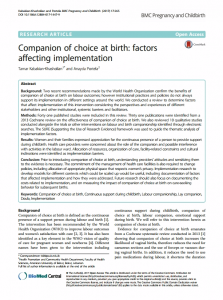
Background
Two recent recommendations made by the World Health Organization confirm the benefits of companion of choice at birth on labour outcomes; however institutional practices and policies do not always support its implementation in different settings around the world. We conducted a review to determine factors that affect implementation of this intervention considering the perspectives and experiences of different stakeholders and other institutional, systemic barriers and facilitators.
Methods
Forty one published studies were included in this review. Thirty one publications were identified from a 2013 Cochrane review on the effectiveness of companion of choice at birth. We also reviewed 10 qualitative studies conducted alongside the trials or other interventions on labour and birth companionship identified through electronic searches. The SURE (Supporting the Use of Research Evidence) framework was used to guide the thematic analysis of implementation factors.
Results
Women and their families expressed appreciation for the continuous presence of a person to provide support during childbirth. Health care providers were concerned about the role of the companion and possible interference with activities in the labour ward. Allocation of resources, organization of care, facility-related constraints and cultural inclinations were identified as implementation barriers.
Conclusion
Prior to introducing companion of choice at birth, understanding providers’ attitudes and sensitizing them to the evidence is necessary. The commitment of the management of health care facilities is also required to change policies, including allocation of appropriate physical space that respects women’s privacy. Implementation research to develop models for different contexts which could be scaled up would be useful, including documentation of factors that affected implementation and how they were addressed. Future research should also focus on documenting the costs related to implementation, and on measuring the impact of companion of choice at birth on care-seeking behavior for subsequent births.